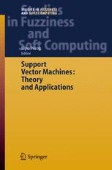Search
Search Results
-
Type-1 Fuzzy Logic
This chapter introduces the basic concepts, notation, and basic operations for the type-1 fuzzy sets that will be needed in the following chapters....
-
Human Recognition using Face, Fingerprint and Voice
We describe in this chapter a new approach for human recognition using as information the face, fingerprint, and voice of a person. We have described...
-
Voice Recognition with Neural Networks, Fuzzy Logic and Genetic Algorithms
We describe in this chapter the use of neural networks, fuzzy logic and genetic algorithms for voice recognition. In particular, we consider the case...
-
Clustering with Intelligent Techniques
Cluster analysis is a technique for grou** data and finding structures in data. The most common application of clustering methods is to partition a...
-
Componentwise Least Squares Support Vector Machines
This chapter describes componentwise Least Squares Support Vector Machines (LS-SVMs) for the estimation of additive models consisting of a sum of...
-
Support Vector Machines for Signal Processing
This chapter deals with the use of the support vector machine (SVM) algorithm as a possible design method in the signal processing applications. It...
-
Theoretical and Practical Model Selection Methods for Support Vector Classifiers
In this chapter, we revise several methods for SVM model selection, deriving from different approaches: some of them build on practical lines of...
-
Adaptive Discriminant and Quasiconformal Kernel Nearest Neighbor Classification
Nearest neighbor classification assumes locally constant class conditional probabilities. This assumption becomes invalid in high dimensions due to...
-
Simulated Annealing Approach for the Multi-objective Facility Layout Problem
In general, facility layout problems are occurred if there are changes in requirements of space, people and equipments. When the changes of...
-
Penalty-Reward Analysis with Uninorms: A Study of Customer (Dis)Satisfaction
In customer (dis)satisfaction research, analytic methods are needed to capture the complex relationship between overall (dis)satisfaction with a...
-
Association Rule Based Specialization in ER Models
Association rules (ARs) emerged in the domain of market basket analysis and provide a convenient and effective way to identify and represent certain...
-
Mining Association Rules with Rough Sets
We say that there is an association between two sets of items when the sets are likely to occur together in transactions. In information retrieval,...
-
A User Centred Approach to Management Decision Making
The management decision making process is becoming increasingly complicated as more detailed and extensive data is available in this information age....
-
Techniques to Improve Multi-Agent Systems for Searching and Mining the Web
Nowadays, an abundant amount of information is created and delivered over electronic media. The information gathering in the Internet is a complex...
-
Gene Regulating Network Discovery
Gene regulation has been an important research topic for the past 30 years and data processing models based on different assumptions have been...
-
Semantic Relations and Information Discovery
The treatment of semantic relations between terms is essential in information retrieval (IR). Each term in a thesaurus might have classes of...
-
Fuzzy Support Vector Machines with Automatic Membership Setting
Support vector machines like other classification approaches aim to learn the decision surface from the input points for classification problems or...
-
Some Considerations in Multi-Source Data Fusion
We introduce the data fusion problem and carefully distinguish it from a number of closely problems. Some of the considerations and knowledge that...
-
Fuzzy Process Control with Intelligent Data Mining
The quality-related characteristics cannot sometimes be represented in numerical form, such as characteristics for appearance, softness, color, etc....
-
Accelerating the New Product Introduction with Intelligent Data Mining
New product development (NPD) is a vital activity for companies. It is also a very risky process since every development stage involves a high degree...
